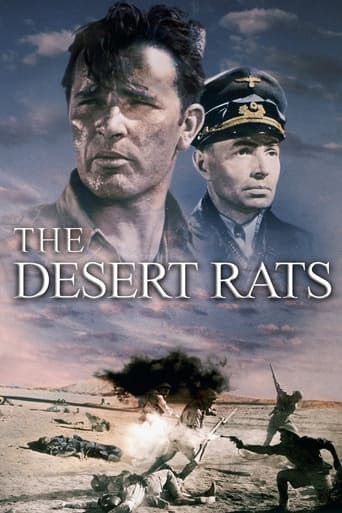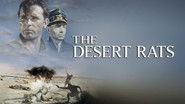HotToastyRag
Oh, Richard Burton looks good in a uniform, his face a little sweaty and his cap tilted on his brow, conflicted about giving an order to his troops. He looks so very good. That's pretty much the only reason why I sat through The Desert Rats, and probably why he made eight wartime movies after this one.The Desert Rats isn't a spectacular war movie. It isn't bloody, it isn't particularly exciting, and it doesn't really have any plot outside the battlefield. Mostly, it's about the strategy Richard Burton, his superiors, and his troops employ in order to stay alive in the middle of the desert before reinforcements can help them. James Mason plays a German bad guy, but he's only given a few scenes, so if it's a James Mason performance you're after, skip this one. And if you're not really interested in strategy, you can also skip this one. Unless, that is, you want to look at Richard Burton in a uniform.
SnoopyStyle
It's 1941. Field Marshal Erwin von Rommel is pushing towards the Suez Canal. Allied forces are hold up in the port of Tobruk threatening his supply lines. Capt. Tammy MacRoberts (Richard Burton) is picked to lead a group of newly-arrived green Australian troupes. They struggle to hold on for two months and end up surviving for eight until relief.The accuracy is questionable to be generous. The story of the raid feels especially unreal. At least, they get captured. This works as an old-fashion war movie. There are bits of good action. Burton and cast are good. It is good action but a little slow in long stretches.
oscar-35
*Spoiler/plot- The Desert Rats, 1953. A fictional account of a British officer in command of ANZAC Austrialian troops defending the North Africa city of Tobruk from Rommel's Afrika Korps in WW2.*Special Stars- Richard Burton, Robert Newton, James Mason, Torin Thacter, Robert Douglas, Charles Tingwell and Chips Rafferty. DIR: Robert Wise. DIR: Robert Wise.*Theme- Audacity in warfare can win battles.*Trivia/location/goofs- American film. Early film role for Richard Burton. James Mason played Rommel again in a 20th century Fox film two years before in 'Desert Fox'. One high British general officer staff member has an obvious American accent during a important briefing. The armor tanks in this film are really American due to the lack of historic panzers so soon after the war. Some German uniform items are clearly WW1 vintage.*Emotion- A good post ww2 film in which the Brits are patriotically but respectfully accounting their win over Das Afrika Korps. Satisfying and somewhat historical with very good casting.*Based On- Historic account of the Tobruk battle.
Steffi_P
In the decade following the close of World War 2, there seems to have been a need to document on film every significant allied operation (at least, every successful one), to give every hero a movie they could identify with. A worthy aim, but the sheer volume of these pictures meant there was a vast variety in quality and approach.This one was produced at Fox and directed by Robert Wise, who had only recently joined the studio after having cut his teeth in the RKO B-unit. During the 40s RKO was making literally the darkest pictures in Hollywood, and much of that shadowy style seems to have rubbed off on Wise. He and cinematographer Lucien Ballard (who certainly knew a thing or two about shadows, having taken his earliest assignments alongside Josef von Sternberg) have created a war picture which is not exactly noirish in story, but is certainly full noir in looks. The gloomy, undefined edges of the interiors give a feeling of entrapment suitable to the situation of the beleaguered troops.There is little opportunity for darkness in a desert, but the outdoor scenes also carry on that feel of confinement. The landscape is often obscured by smoke or sandstorms. We see silhouettes that could be friend or foe, and glimpse enemies through gun sights. There are few clear shots of the action, more often just mid-shots of the soldiers which make it hard to tell their position in relation to the combat. The impression we get is – quite accurately – that in the heat of battle the ordinary foot soldiers can rarely tell exactly what is going on, whether they are winning or losing, or how to proceed beyond the execution of the latest order. It was things like this – a bit of lateral thinking to give us a feeling for the protagonist's plight – that Robert Wise was really good at.The post-war period had seen the rise of the UK film industry, and unsurprisingly the best British stars were being poached for Hollywood productions. So here we have Richard Burton, at his most inappropriately theatrical and unshakeably serious (how often have you seen Burton smile?), and yet somehow he is very enjoyable to watch. James Mason had gone in a few short years from dashing male leads to slightly sinister middle-aged types, but he could pull it off, and perhaps even enjoyed villainous roles like this a bit. Speaking of enjoying villainous roles, what have we here? Robert Newton, playing – of all things – an alcoholic ex-schoolteacher. He always showed some potential in his straight roles, but to be honest he is just a bit boring without snarling and eye-rolling.The original music is by ex-Disney intern Leigh Harline (he wrote When You Wish upon a Star, you know). Actually there isn't very much original music to be heard in the Desert Rats, the score being mostly snippets of Waltzing Matilda, but there is one interesting point about the music. Take a closer look at that opening credits sequence. At one point, you see a soldier with a trumpet pick up the tune. This kind of makes sense – sounding the charge and all that. Then, a shot or two later, a soldier dives into a shell hole and pops back up… playing a clarinet! What is going on there? I actually whizzed the tape back and forth a few times to check if any more of the orchestra appears, but sadly they don't. I would have liked to see Richard Burton come on at the end, playing a trombone.Anyway, enough of that. It's odd in a way that Hollywood put such a lot of energy into honouring the heroes of the recent combat, because by and large the veterans themselves stayed away from these pictures. The target audience was more often the younger generation who hadn't been old enough to fight at the time. Grim authenticity was becoming less of a priority (and while the Desert Rats is certainly gritty and respectful it does once or twice strain credibility and historical accuracy), and the anti-war mood had not yet caught on (although this picture is certainly far less gung-ho than was the norm a few years earlier). The most a war picture really needed to be at this point was entertaining, and the Desert Rats is victorious on this front. It is neither deep nor spectacular, but it is a good and easy watch for your eighty-five minutes.




